ALLIGATOR
BEHAVIOR page 6i: ON LAND; WALKING AND BASKING page 9 page 1 2 3 4 5 6 7 8 10
This
page was born 10/18/2022. Rickubis designed it.
(such as it
is.) Last update: 05/12/2023
Images
and contents on this page copyright ©2001-2023 Richard M. Dashnau
Alligators
are amphibious (but not AMPHIBIANS) and are in the water
most of the
time.
Therefore it is worthy of note when they are
on land, especially
when they are doing more than just absorbing solar
energy. Here is yet another page of terrestrial alligator
antics.
From Brazos Bend State Park
on 08/28/2022 Some
hours
after the action with the gator mom on Spillway Trail
(described
elsewhere), this alligator was foraging
near
the Observation Tower in water that had reappeared in Pilant
Lake.
Although a few small fish and occasional tadpoles were
visible,
there was a lot less activity in the water than usual.
The alligator
had mud all over the top of its head, a really big lump of mud
on the
back of its head. A small dragonfly used the mud as a
perch
while
the gator slowly cruised around. The gator
submerged briefly, then
moved East, and towards the common crossing spot (I saw many
gators
leave the lake at that point-a few yards East of the restored
culvert-over the last month or so.).
Since it appeared that the
hunting was poor, I thought there was a good chance that this
one would
cross too, so I moved a bit past that point (to get the
sun
behind me) and turned to watch.
A few minutes later, a group
of 8 visitors walked up, and I got their attention and
suggested that
they watch the area near me. The gator crossed, to the evident
enjoyment of the group. The
people kept far back from the
crossing gator. After the gator had crossed, I was able
to
talk
to the folks, who were mostly new visitors to the park (two
were
visiting from Northern U.S.).
Sharing experiences like this
with park visitors-especially those new to the park-is one of
the
biggest rewards for working at BBSP,
When
I've seen an alligator's head covered with mud like this, it
was pretty
obvious that the alligator had been burrowing (because I had
seen it
using the burrow). With so much mud on
top of its head, I
think that this alligator had been burrowing or moving in
and
out
of a burrow( or den); or, the alligator had buried itself in
the soft
mud.






Update
05/12/2023 - I'm going back to
08/14/2022
for
this update.
Why? I have a lot
of material captured that I haven't used yet. I'm always getting
more,
and some is very
interesting (at
least to me).
But gathering material for 20+ years has shown me an
interesting
perspective for that material--time. Without meaning to (at
first),
I've been
able to show
various changes over time...20 years! The dry
weather we experienced in 2022 caused some radical changes in
the area,
especially at Brazos Bend State
Park.
I was able to witness-and record-how some of the life in
BBSP
was affected; especially the alligators. So, this update
wasn't
as much "fun" as some others
I've done, but
is a quick record of conditions at the park that day, and how
another
alligator was dealing with them. I've shared some of the other
changes
at
BBSP
over the years here in my domain
Looking at
some of them now, I wish I'd captured and/or shared a bit more
detail.
So...this update.
08/14/2022
From lack of rain, water had been evaporating from BBSP since
March.
But a little rain fell in August. This alligator
was moving
East, out of Pilant Lake.
About a month before, alligators
had worn a trench in the mud along the same route, but it became
hidden
by the growing plants, and smoothed by the recent short rains.




The alligator got to the puddle next to the Spillway Bridge,
which
wasn't very deep. A closer look at the images (and at the
video
clip here) will show a groove that
the alligator made in the
really soft mud visible behind it. I thought it might stay
and
rest, or even try to hunt, but I suspected nothing would be
found in a
puddle that
was a few weeks old, though there were tiny creatures moving
there.




The
alligator
stopped in the water near the bridge. But it didn't stay
long, and walked through the puddle and back onto the mud.
It
rested there while it looked around.
It seemed to be
deciding what to do. Then it started walking again. It
walked
across mud that had become firmer during the drier period, and
then
covered with fresh
greenery from the recent brief rain.
Impressions in the mud might be tracks from other travelers.
The
alligator kept going, apparently moving towards Elm Lake
(still
about 1/4 mile away). I left it when it rested in another
dry
spot, hidden by plants. Here's the link to the
video
clip again.




From Brazos Bend State Park
on 07/10/2022
Over
the 20 years I've been interpreting at BBSP, one of the Top
Five
questions asked is "How fast can an alligator move?" I've
read
they can move quickly. For years
I've tried to capture video showing how fast an alligator
can move when
it wants to. Since most gators are relatively immobile, or
moving at a
leisurely pace--but can burst
into very quck movement without notice-I haven't had
any
luck. Shooting hours of footage of alligators not
going
fast, just on the chance that I might catch one bursting
into action
wasn't an option. I've seen
them move fast, but hadn't had any luck recording it.
Until...July 2022.
I'm going back a few months for this update--to a time just
before Pilant Lake became dry, 7/10/2022 . Pilant Lake
is
still dry now
(10/06/22). I was on the North side of 40-Acre Lake
going
West. The
water
in Pilant Lake was low, receding more every week due
to
evaporation. An alligator-which I estimate to be about 4'
long-crawled
out of Pilant Lake onto the trail. I've always loved
watching
alligators cross
the trail, and I started recording this one. As
they often do, this alligator laid down at the edge of the
trail.
Meanwhile, I interpreted for the vistors nearby.
Because of
the situation, and the body position of the
alligator, I expected it to
get up and walk across into 40-Acre Lake at any minute. But,
I was
wrong.
The alligator didn't walk across. It RAN
across the trail.




animated GIF at normal speed
animated GIF at slowed down
Pilant
Lake 07/10/2022
Egret, Stilts, Spoonbill,
Heron 07/10/2022
This
was
a very uncommon sight, at least for *me*. To put this
into
perspective; I've been volunteering at BBSP since
2001. I've
spent most of my time at this park out on the trails, and
usually in my
favorite
ecology--the wetlands and lakes. I've seen *many*
alligators crossing trails, and moving on land. A quick
count through
my archived imagery yielded at least 150 separate occasions
of
alligators moving on land
that I've recorded in photos or
video. There are many others that I seen but have not
photographed.
I've gathered a few examples without context on this
walking
gator page.
Out
of all those experiences I can only recall a few where the
alligator
was not high-walking at the usual stately pace. Today was
the only time
that I can recall ever seeing an alligator run across a
trail. By the
way,
I have seen alligators do a "fright dive" when scared off of
a
basking spot. I don't count those, since they don't cover
much ground
(rarely more than the length of the alligator doing the
dive) and
therefore only
involve a few steps. I was impressed by the film
footage (about 10 seconds), so I spend way too much time
editing the
footage, slowing it down, etc. That, and the other crossing
described
below are together in this
video
clip
showing 2 alligator crossings.
Around
that time, discussions about crocodilian movement over land
had
appeared in various media I follow. I saw a video clip
showing a
bounding Cuban Crocodile (Crocodylus rhombifer) that was
making the
rounds.
Holy cow! Those things can MOVE! If you can, do an online
search for those clips. If you see any, imagine one of
our
alligators moving that quickly towards you. I couldn't
even
begin
to react in such a situation. Further
investigation didn't
give me any more context to why they move that way (Do they
ambush prey
on land that way? Is it only an escape behavior?)
I'd seen
"galloping" mentioned in the literature I've read about
crocodilians--but
only briefly described as an alternative to "high-walking"
as a mode of
moving over land. (They can also "sprawl-walk" and
"belly
slide"
as other alternatives").
This study, released in 2019, compares
many different species of crocodilians and seeks to discover
how often
"galloping" (or "bounding") occurs: "Divergent
evolution of
terrestrial locomotor abilities in extant Crocodylia"
by John R. Hutchinson, Dean Felkler, Kati Houston, Yu-Mei
Chang, John
Brueggen, David Kledzik & Kent A. Vliet
There's a summary of the study here: https://www.theguardian.com/science/2019/dec/17/see-you-later-trotting-alligators-many-crocodiles-can-gallop
What I take from this study as relevant here, is that:
1)
most crocodilians can gallop, and can move fast when they
do.
2)This
behavior becomes limited as the animal gets larger.
3)most
"alligatoroids" do NOT gallop. Paleosuchus
palpebrosus(Cuvier's
caiman),Caiman crocodilus(spectacled caiman),Caiman
latirostris(broad-snouted),
Alligator missippiensis, Alligator sinensis (not
included) 4)
The species that do not gallop can still run
as
fast as the species that do gallop.
My
video
shows how quickly the alligator crossed the trail, along
with slowed
breakdowns of movement (I've made the animated gifs on this
page from
the same footage). There are dust plumes under
the gator's
feet as
it
moves! The slowmotion view shows how the forefeet don't seem
to add
much thrust. To me, it seems that just the toes of the front
feet
touched the ground while crossing the trail. When
the gator
moved
down slope, it
seemed like the front feet barely touched the ground
at all--but by then it was in the plants so the front legs
were hidden.
The trail at that point is about 8 feet across (compared
with my
walking stick) but I didn't think
to take a picture at the time. The
alligator appears to be half that, so about 4 feet long.
The
images below are frames from the video.













About 30
minutes later, I was near the Observation Tower (about 100
yards East
of the gator crossing). A larger alligator was moving
through the
mud near the culvert. The gator moved towards a
favored crossing
spot.




I walked past to get the sun behind me, and the gator
crossed. Although I've filmed many
alligator crossings I have rarely caught the moment that the
alligator
lifts off the ground and takes the first step. I was
very
lucky
with the running alligator. But I missed the
take
off on this
one.


animated GIF at normal speed
animated GIF at slowed down
We can watch this one in the video (and the animated
gif)
and compare to the smaller run that ran 30 minutes
before.
This was a typical high-walk. I also took pictures of my
stick on the
trail where the gator had crossed to
compare with the
alligator. I guess this one was about 8 feet
long.
The images below are frames from the
video. The person in the background (behind the tower)
is
standing where the small gator ran across earlier.











An
alligator crossing the trail looks so...deliberate. Once a
large
alligator has decided to leave the general safety of the
water for a
certain purpose, there is little that will change its
course.
Smaller gators (less than
4 ft or so) tend to be more careful, and
can be discouraged easier. But I've seen large gators
walk
through a group of people, another move towards a fish that
had been
dragged to shore-and even pursue that fish if it's been
taken out of
the water. I watched an alligator "chase" a Great Blue Heron
that had
caught a fish out of a small pool that the gator had
claimed.
The
fish was large, so the Heron walked out among the trees,
then dropped
the
fish for another spearing (as they do). The alligator saw
that, and
walked into the woods after it. The heron picked up its fish
and moved
further in; and the alligator followed with that slow,
deliberate walk.
I lost sight of them,
so I don't know how things turned
out. The sight of a large alligator pursuing something
it
wants
with that slow, focused walk can be intimidating. But
imagine that
alligator running and that's nightmare material. But,
as
stated,
I've
seen many gators crossing land, and have seen very few
moving with any
rapidity while doing so--whether running or otherwise.
An odd thing
about the usual high walk for me is that it happens slowly
enough to
hide some subtle details of the movement. But adjust the
footage a bit,
and I think I can see a "strut" as the gator pulls its tail
along with
each
step. It's clearest to me while looking at the rear
legs
and tail. 1) Left foot forward, put down flat. 2) Push
with
left
foot as right steps forward. 3)right foot flat. 4)Push
with
right
foot as Left Heel lifts and push with left toes (?),
repeat I
think the "heel lift" is where the hips are lifted and tail
is pulled
forward. Someday I'll take a closer look at some of the
gator movement
studies I've found to see if I'm guessing right. So here's
my very
verbose description
of 2 sightings that lasted about 1 minute
each. One other thing (for general information); I've
gotten
the
following definition of animal gaits in this report:
Gait characterisation and classification in horses Justine
J.
Robilliard, Thilo Pfau and Alan M. Wilson
A
gait is a repetitive ‘manner of walking or running’. Gaits
are discrete
patterns of foot-falls and are divided into symmetrical and
asymmetrical. In symmetrical gaits, each
forelimb
or
hindlimb is considered to be used equivalently
with the same
control of mass, and left/right foot-contacts occur at
equal
time
intervals. Common examples of symmetrical gaits in
quadrupeds are walk,
trot and pace.
In asymmetrical gaits, the limbs are considered to
be employed differently, as there are different limb forces,
and
foot–ground contacts are not spaced evenly in time. Common
examples of
asymmetrical gaits in quadrupeds are:
canter and gallop.
07/03/2022
- From
Brazos Bend State Park
mostly on 07/03/2022
I'm
posting this in November, after we've gotten rain. I'm using
this
update to record some changes in Pilant Lake
starting from February 2022, up to 7/3/2022--which is when I
witnessed
the alligator demonstration. Let's go.
The picture below shows Pilant Lake on 2/6/2022. Point of
view is a few
hundred yards West of the Observation Tower.

The
pictures below shows Pilant Lake on 6/5/2022. At this time,
a lot of
the water had left the lake. The channel running from the
left was
partially from the flow of water draining to the lower
area, and
partially from alligator traffic. The second picture clearly
shows the
drag marks and footprints of at least one gator. The third
picture was
taken later in the day, after the activity
that was going on in the background of the first two images,
and the
gators left the lake. The long image below
those two shows what was visible in the background of the
two images.
I've already described what was going on back there on one
of my other web pages.
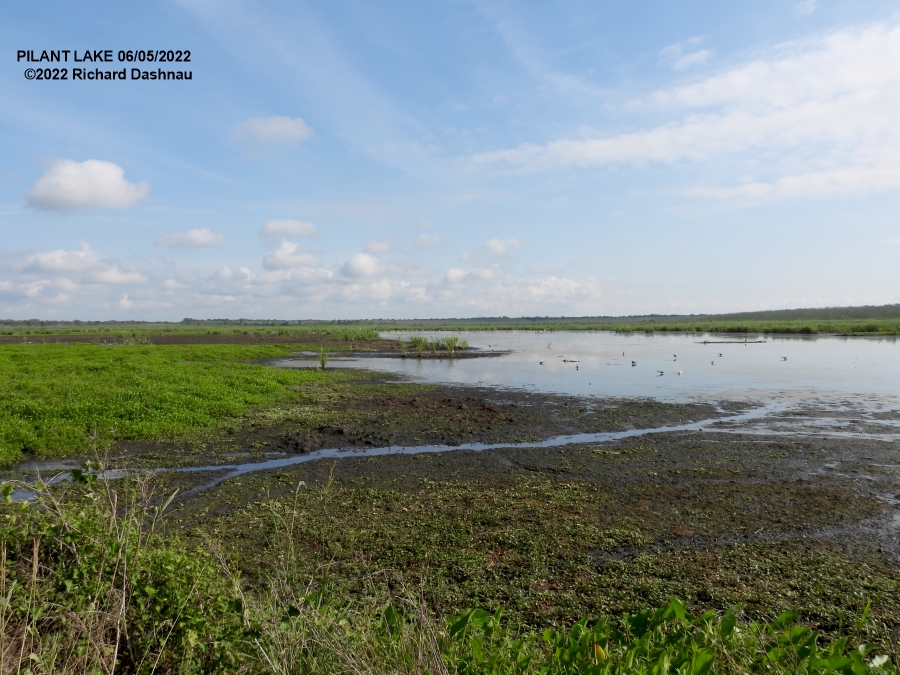
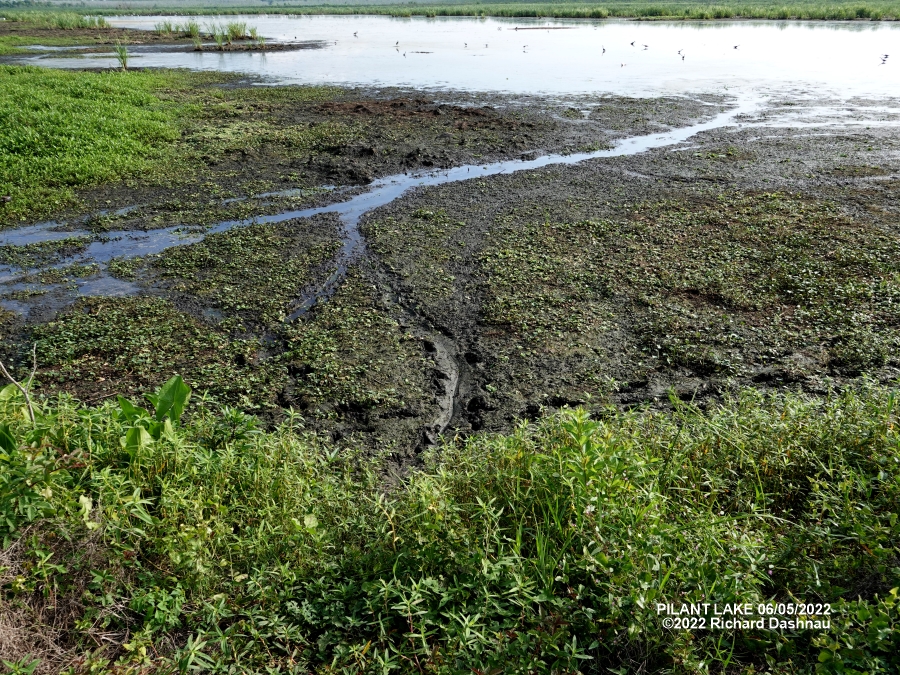
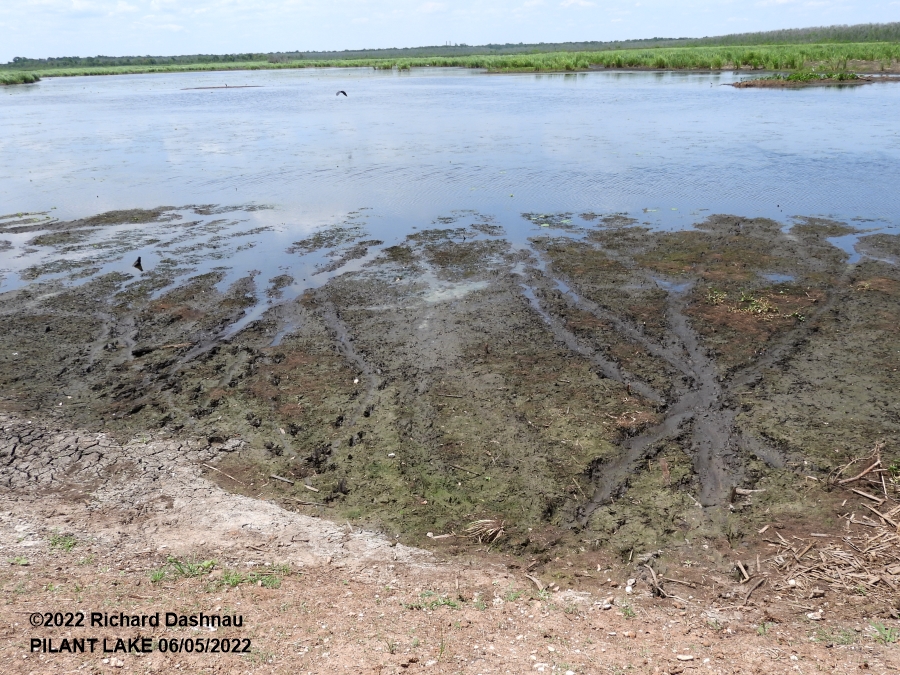

The first two pictures below are from a week later,
06/12/2022.
This is about halfway down the Spillway Trail, West of
the
Observation Tower. The area to the North, usually submerged
was
getting
growth, while the remaining aquatic life was in the water
near the
trail. The second two pictures show Pilant Lake on
6/19/2022.
There's water there in mid-June, but it continued to
go away.
The surface of the water was bare, and there
were
few
alligators visible. There were some birds foraging on the
mud flat in
the center, mostly Roseate Spoonbills. The Spoonbills
were there because many had hatched on the West end of
Pilant Lake.
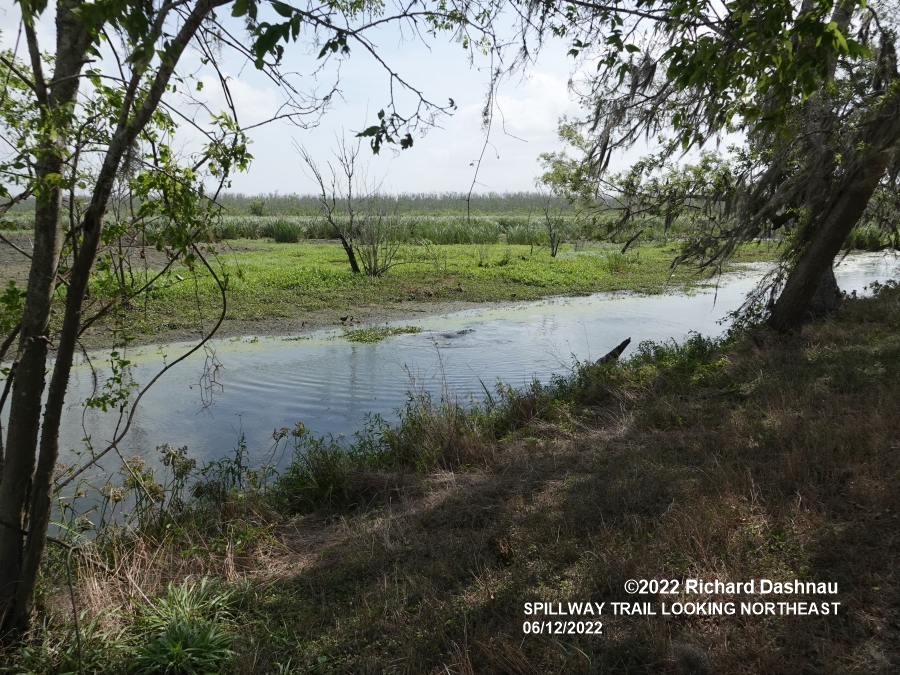
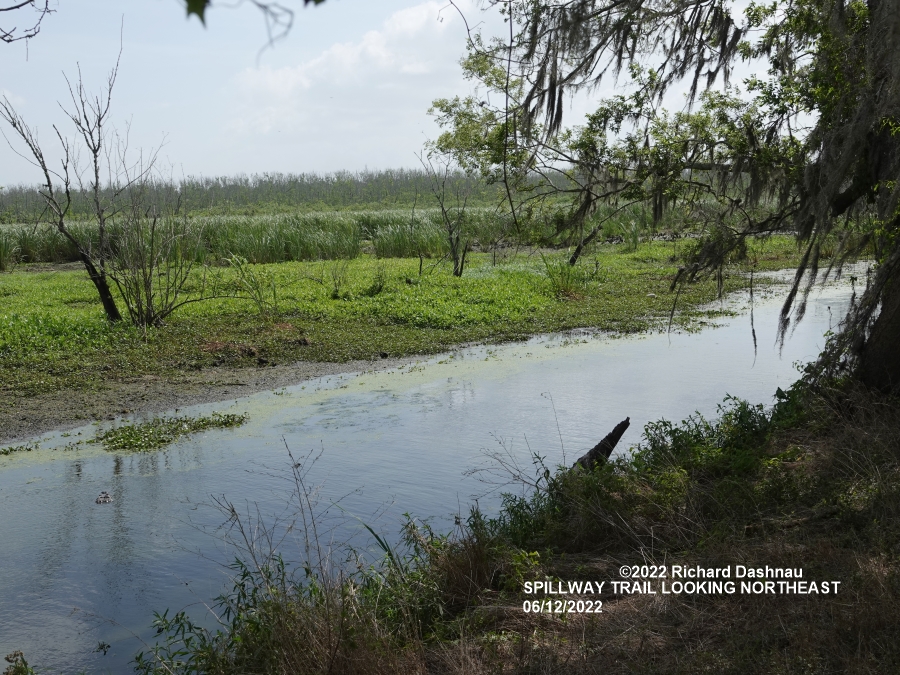
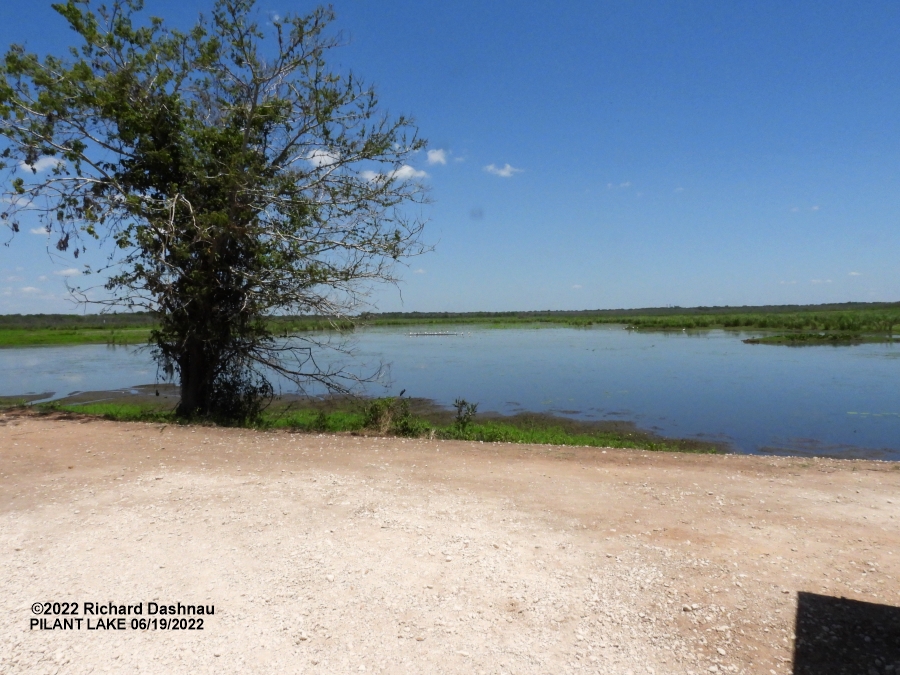
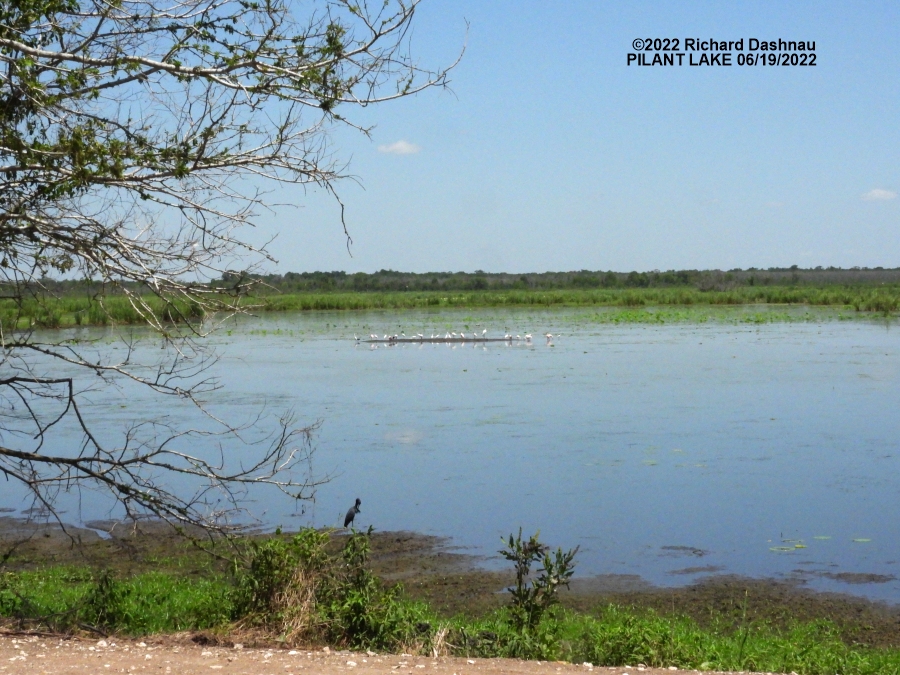
Now--we
are at July 3, 2022. Over the course of the year (I'm
writing this in
November) we watched the lakes shrink until mid August.
Many
people asked what the alligators do when they
lose a lake, or where
they go when they leave a dry lake. Trenches were
visible
when
things were totally dry--but by they hadn't gotten that bad
this week.
The North side of the Spillway Trail
had some water remaining near
the Spillway Bridge, but it turned into a morass of muck as
one moved
East. The two images below show the low water about
halfway
down
the trail.
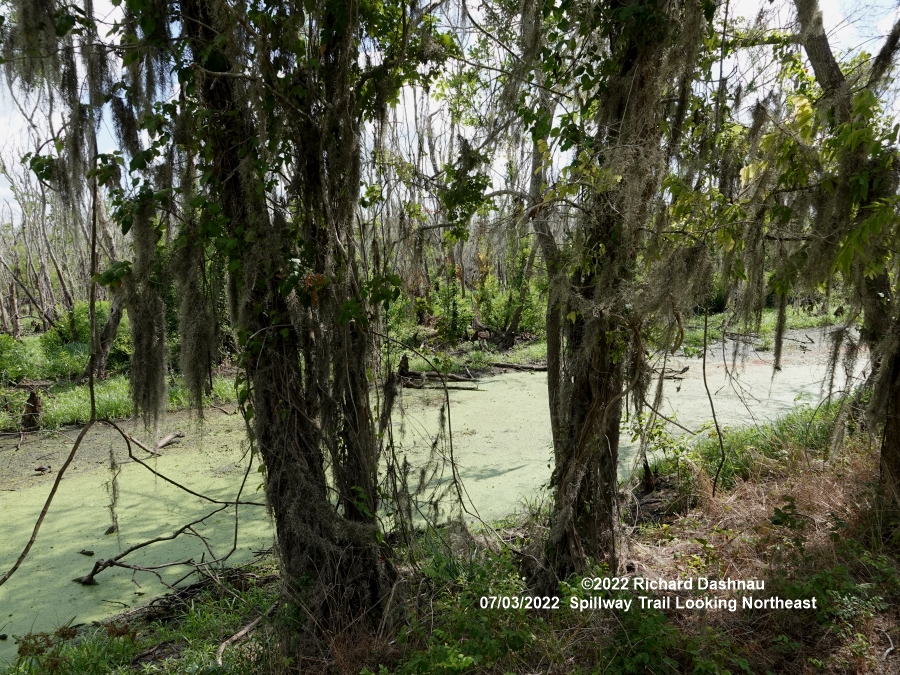
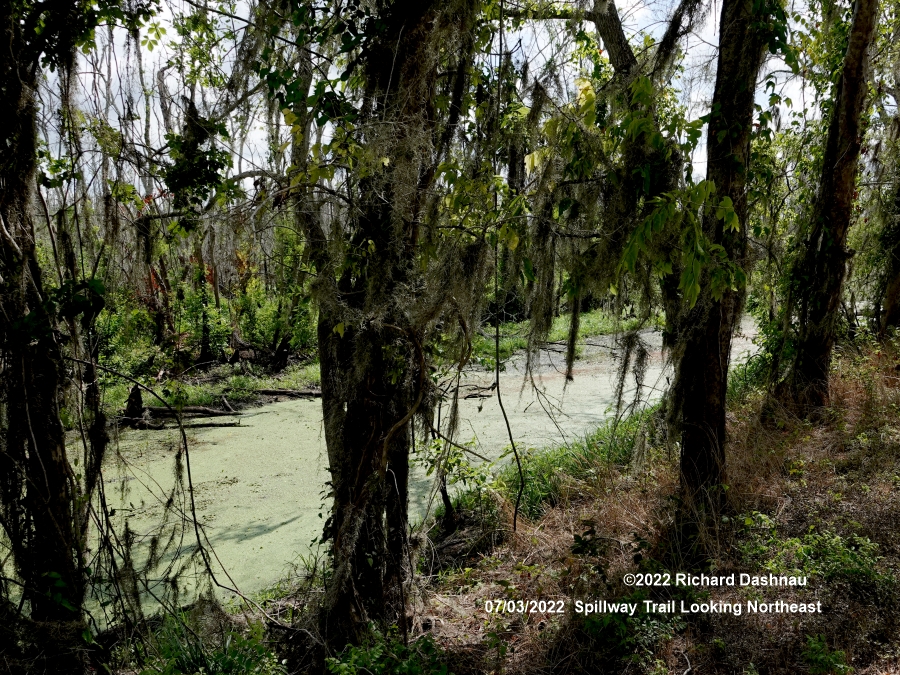
There
were
still a few alligators along that length, but some of them
were
not friendly to each other. I followed one that had been
chased East.
It moved through the deep muck, pushing a blob of
water and mud in front of it. There is also video of
this
interesting movement
at
this link.
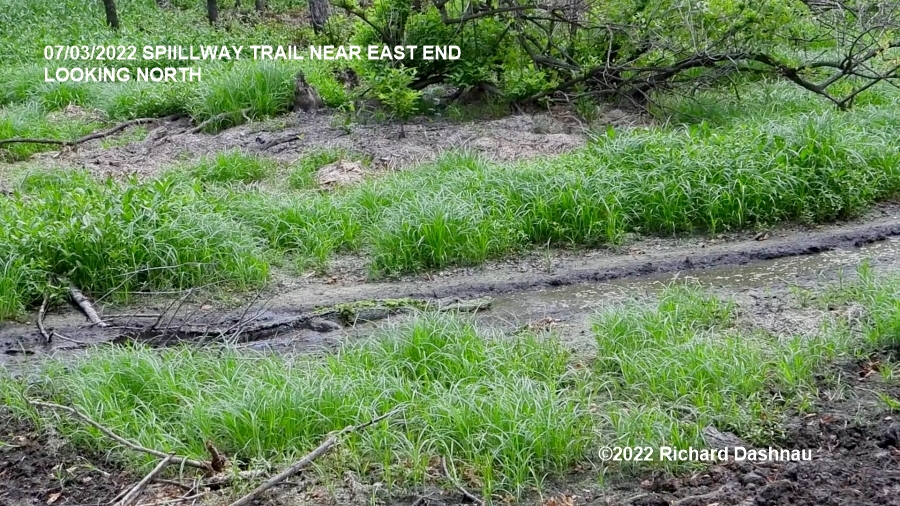
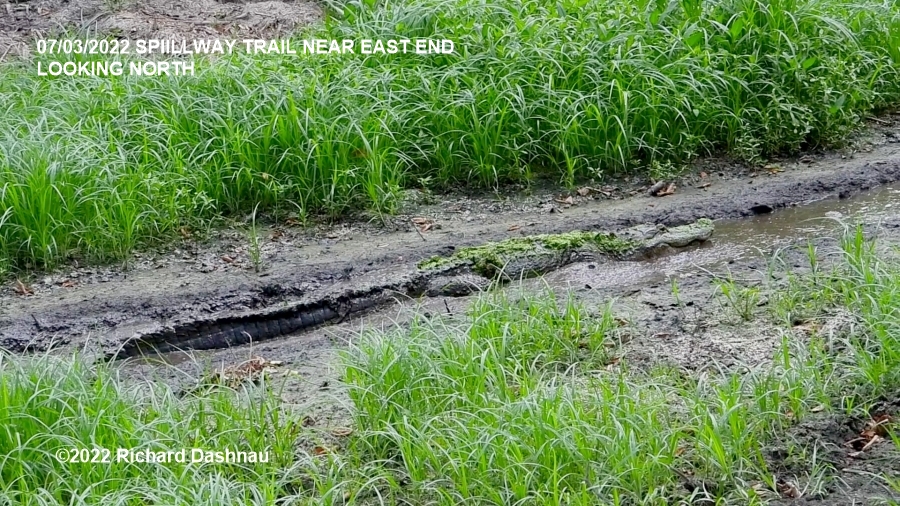
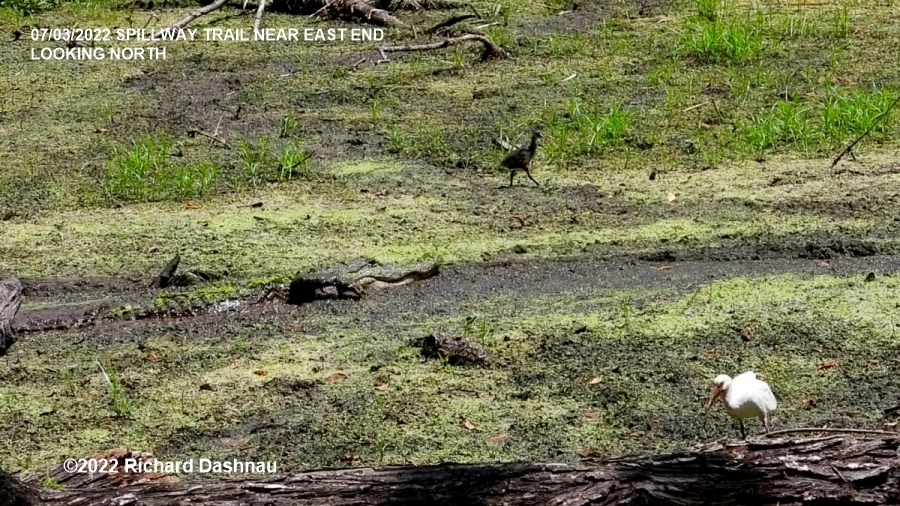
It
moved by using a walking/sliding gait. Occasionally it
lifted
a
leg out of the mud to take a step. It continued walking at a
"trot",
with rear leg on one side and front leg on the other moving
forward for each step.
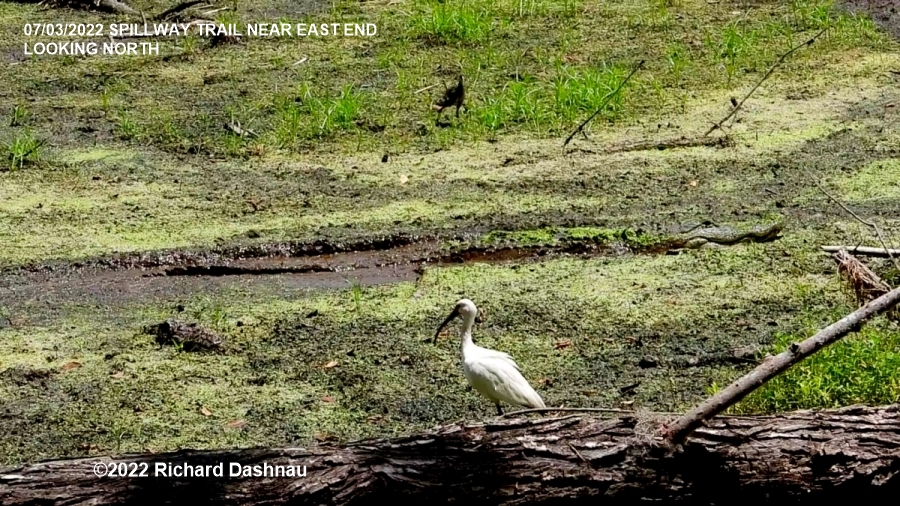
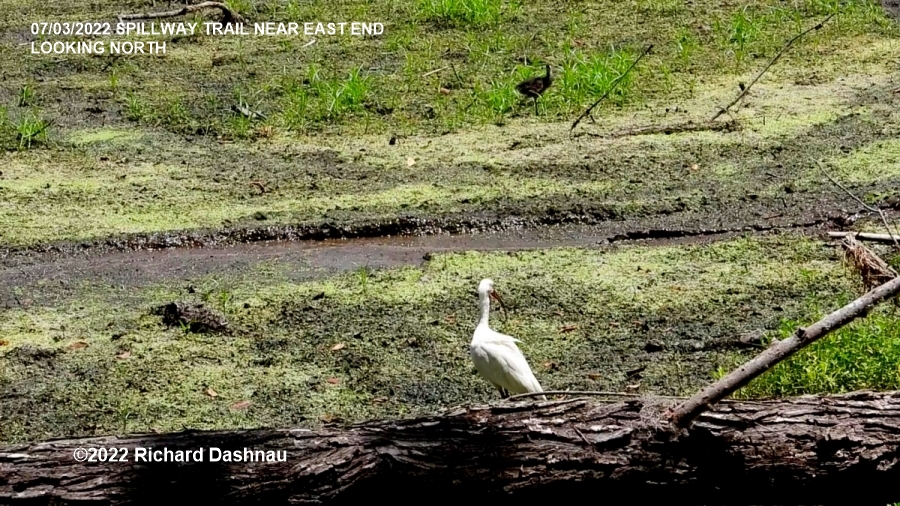
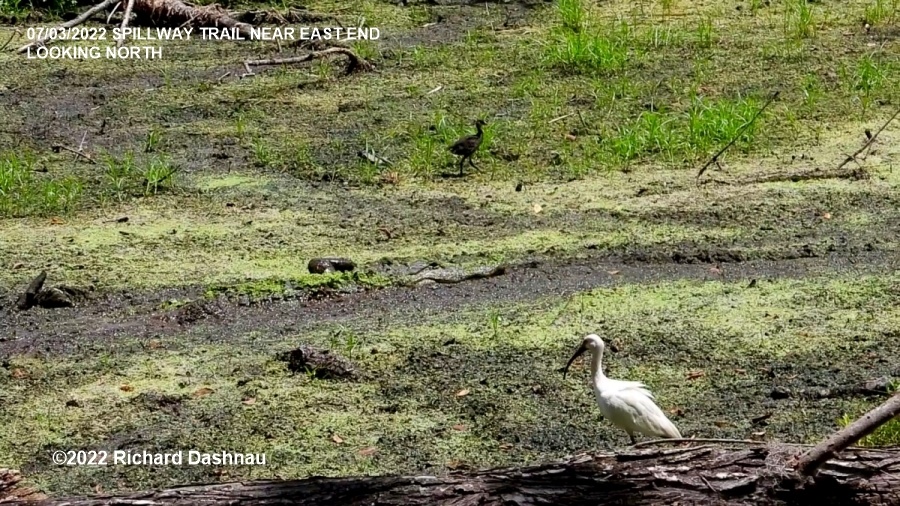
A young Gallinule and a White Ibis that had been foraging in
the mud
moved back as the alligator pushed by.
Even when apparently mired in a morass of mud; an
alligator
can still move fast
enough
to grab prey if it is close enough. The middle picture
shows
the
blob of water that moved ahead of the alligator. At
first
glance,
it appeared to be a current or flow, but it was entirely
being pushed by the alligator.
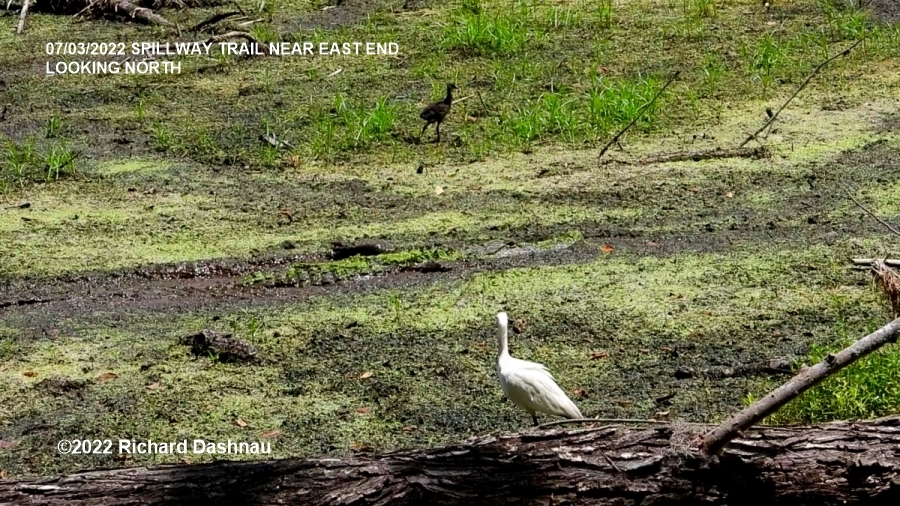
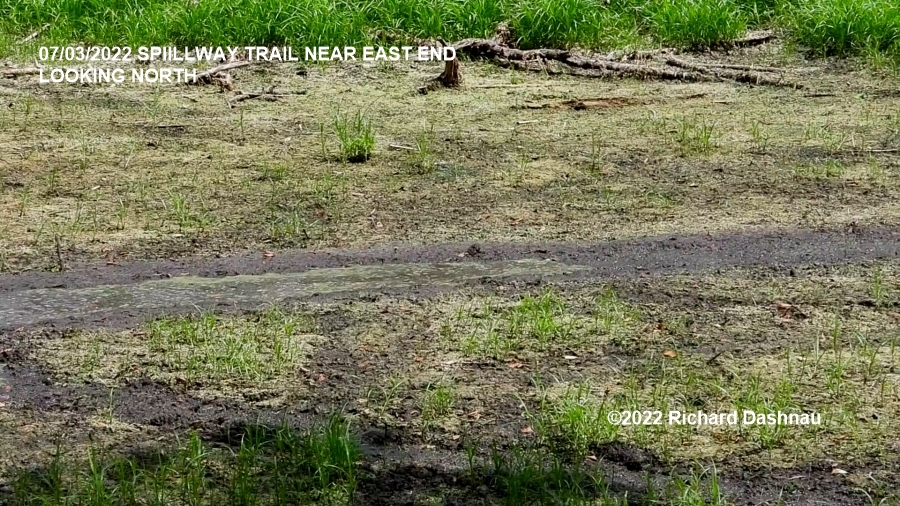
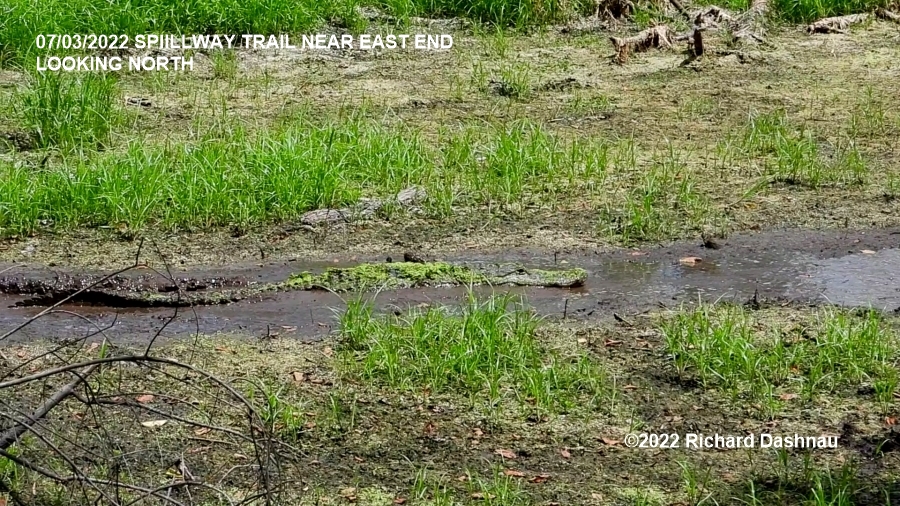
The
last two images show that the level of mud behind the gator
was
lower--demonstrating that it was the force pushing the
liquid. The
alligator made it to the far end of the trail, where there
was a
deeper area in the corner where the Spillway Trail meets the
Elm Lake
Trail. How many other alligators must have taken the
same
route,
and formed that trench?
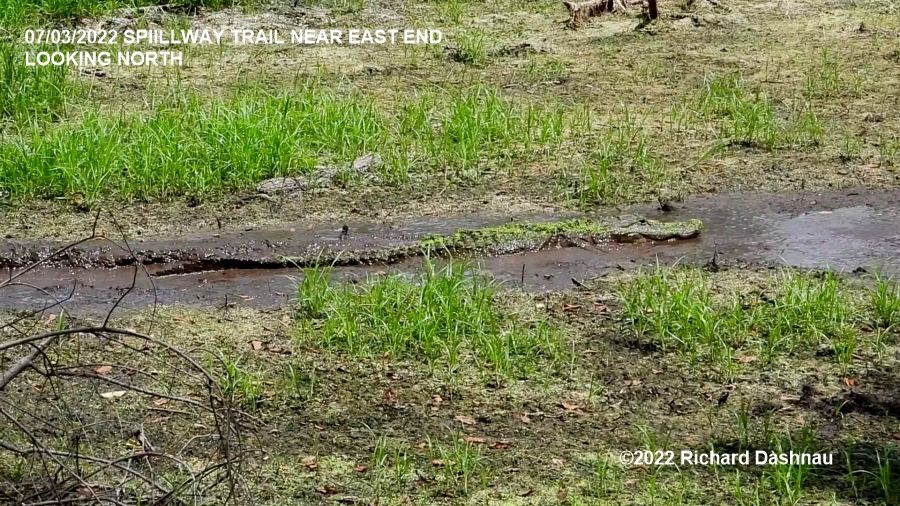
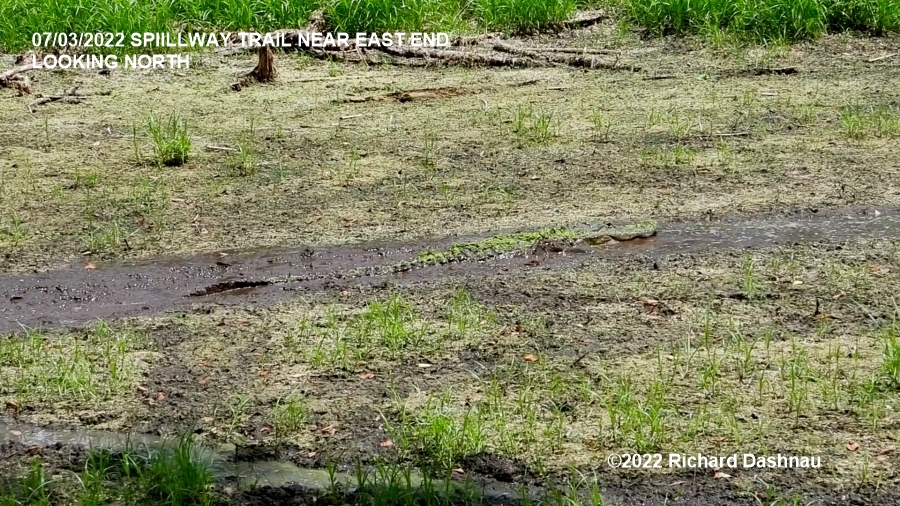
And,
this page shows
alligators at the park, on land, near various landmarks at the park.
Go back to my
main alligator page, Alligators
Go
back to my home page, Welcome
to rickubis.com
Go
back to the RICKUBISCAM
page.
Go
back to the See
the
World
page.









































































